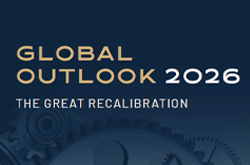2020: A stabilising business cycle
2019-2020 growth outlook
The International Monetary Fund (IMF) cut its world growth forecast further for both 2019 and 2020 to 3% and 3.4% in its October World Economic Outlook update. While we agree on the 2019 figure, we are slightly less optimistic for 2020, expecting a more modest rebound to 3.2%. China remains the main engine of world growth (about one third) even though its growth rate will decline towards its potential growth rate, meaning that growth should be close to the 6% mark in 2019, and 5.7% in 2020. The trade conflict with the US is China’s major headwind, weakening the outlook in 2020. Debt accumulation has slowed but corporate deleveraging is partially offset by government and household debt accumulation, with the total reaching 257% of GDP in 2018.
In the US the Institute for Supply Management (ISM) manufacturing index fell to a decade low in September, but that indicator typically lags the global manufacturing PMI by three months. The latter tends to follow the Chinese one. Q4 2019 GDP growth estimates are mostly below 2%, to compare with the 2.1% p.a. August 2019 Congressional Budget Office estimates of the potential growth for the years 2019 to 2023.
We emphasise that our nominal GDP growth estimate stand currently slightly above 4% YoY. According to our proprietary models, the recession of probability now stands at 14.1%, i.e.significantly lower than the Euro Zone’s one (26.5%).
Regarding the latter area, our model based on the composite PMI sees GDP accelerating somewhat in 2020. The policy-mix in the Euro Zone has been misaligned, with loose monetary policy and tight fiscal policy. Fiscal policy is becoming somewhat looser in the Euro Zone.
Against a background of soft landing and inflation mostly not threatening, we can count on monetary policy staying accommodative and fiscal policy becoming globally looser.
Political Uncertainty
Besides, we observe social unrest in various countries which have been linked to the lack of government effectiveness and/or to high inequality amongst the population. According to our studies, the link between these two factors appears to be weak. While one could expect the countries combining low government effectiveness and high inequality to be the most at risk of social unrest, this is not always true, as Chile exemplifies.
That being said, this risk has to be considered at a time when other political issues (Brexit, trade war) may be driven to the background.
Finally, in 2020 there will be a US presidential election, the outcome of which is uncertain. However, we can remind our readers that before the Trump years, the Fed policy did not show a particular pattern with respect to elections or the party of the president.
January 01, 2020




